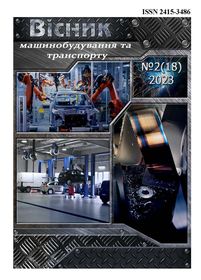Model of passing a turn by a vehicle
DOI:
https://doi.org/10.31649/2413-4503-2023-18-2-87-93Keywords:
curve of the track, intersection, stability of the car in turns, car controllabilityAbstract
The car turning model is considered, in particular at an X-shaped intersection with an arbitrary intersection angle of the tracks. The conditions and restrictions that are imposed when the car enters a turn are analyzed. It is shown that, when the car moves from straight to curved sections, angular accelerations acting relative to its vertical axis have a significant influence on the redistribution of the forces of interaction between the wheels and the road surface and, accordingly, on the stability and controllability of the car. The analysis of motion trajectories, which consist of conjugate rectilinear and curvilinear sections and are described by the equations of a circle, a parabola, and a hyperbolic cosine, is provided. It is shown that choosing a trajectory according to the law of parabola and hyperbolic cosine slightly reduces the turning radius of the car, but significantly reduces the curvature gradient in the conjugation zone and, accordingly, reduces angular accelerations and increases the resistance of the car to rotation relative to the vertical axis. For a smooth transition from a straight path to a curved one, a special logistic dependency was used to connect (stitch) different sections of the route. This made it possible to describe the trajectory of the car by a smooth function, the first and second derivatives of which are also smooth functions. For the selection of the trajectory of passing turns with a slight curvature of the route, a dependence in the form of a fourth-degree polynomial, the curvature of which at the point of conjugation is equal to zero, is proposed, which ensures a smooth transition from a straight to a curved section and ensures passing a turn with minimal dynamic loads.
The developed model allows you to design the trajectory of turning for various types of intersections in real time and can be used to build dynamic models of car movement along given trajectories, as well as to build simulators for unmanned vehicles.
References
Кашканов А. А., Кашканов В. А, Кашканова А. А. Моделювання траєкторії руху автомобіля при дослідженні дорожньо-транспортних пригод. Вісник машинобудування та транспорту. Вінниця: ВНТУ, 2019. URL: https://doi.org/10.31649/2413-4503-2019-9-1-53-65.
Макаров В. А., Волохов. А. С., Куплінов А. В. До питання вибору математичної моделі для дослідження курсової стійкості руху легкового автомобіля. Наукові нотатки: міжвузівський збірник. Луцьк, 2010. Вип. 28. С. 311–316.
Розвиток математичної моделі криволінійного руху двовісного автомобіля» / Кальченко Б. І. та ін. Вісник Нац. техн. ун-ту «ХПІ»": зб. наук. пр. Сер.: Автомобіле- та тракторобудування. Харків: НТУ «ХПІ». 2017. № 13(1235). С. 45–50.
Вербицький В. Г., Макаров В. А., Костенко А В. До питання визначення та аналізу показників курсової стійкості руху легкового автомобіля. Вісті Автомобільно-дорожнього інституту. 2009. № 2(9). С. 21–25.
Fedotov A. I., Tikhov-Tinnikov D. A., Ovchinnikova N. I., Lysenko A. V. Simulation of car movement along circular path, 2017. IOP Conf. Ser.: Earth Environ. Sci. 87 082018. DOI 10.1088/1755-1315/87/8/082018
Xiaohui Zhang, Jie Sun, Xiao Qi, Jian Sun. Simultaneous modeling of car-following and lane-changing behaviors using deep learning. Transportation Research Part C: Emerging Technologies. Volume 104, July 2019. P. 287–304.
Modeling Car-Following Behaviour of Turning Movements at Intersections with Consideration of Turning Radius / Fulu Wei et al. Journal of Advanced Transportation. 2020. Article ID 8884797, 9 pages. URL: https://doi.org/10.1155/2020/8884797
Vehicle Motion Prediction at Intersections Based on the Turning Intention and Prior Trajectories Model IEEE/CAA / Ting Zhang et al. Journal of Automatica Sinica. October 2021. Vol. 8. P. 1657–1666. DOI: 10.1109/JAS.2021.1003952
Мандрика В. Р., Шликова В. Г Керованість і стійкість руху автомобіля B-класу з системою ESP. Вісник Нац. техн. ун-ту «ХПІ»: зб. наук. пр. Темат. вип.: Транспортне машинобудування. Харків: НТУ «ХПІ». 2013. № 31(1004). С. 60–65.
Довжик М. Я., Калнагуз О. М., Сіренко Ю. В. Криволінійний рух чотириколісної машини з використанням супутникової навігаційної системи. Наукові горизонти. 2020. № 7(92). С. 126–135.
Модель руху автомобіля при перебудові смугами / Р. М. Рогатинський та ін. Науково-прикладні аспекти автомобільної і транспортно-дорожньої галузей: матеріали VII міжнарод. наук.-прак. конф. (м. Луцьк, 14–16 черв. 2022 р.). Луцьк, 2022. С. 103–106.
Модель обгону автомобілем на прямій трасі / Р. М. Рогатинський та ін. Підвищення надійності і ефективності машин, процесів і систем. Improving the reliability and efficiency of machines, processes and systems: Матеріали V Міжнародної науково-практичної конференції, 19–21 квітня 2023 р. Кропивницький: ЦНТУ, 2023. С. 17–19.
Downloads
-
pdf (Українська)
Downloads: 129



